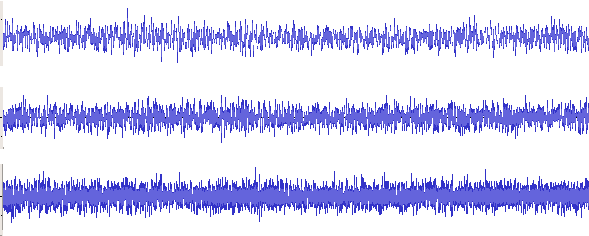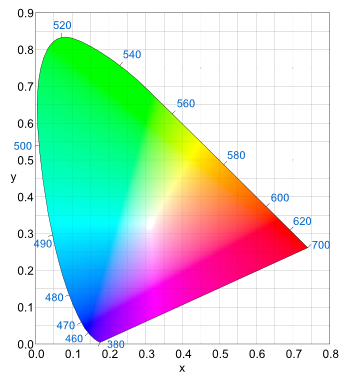Olfactory White
December 3, 2012
People were exposed to quite a lot of
white noise towards the later part of the
last century. In those days,
radio communications were through
analog channels, and you would hear white noise when your
FM radio was tuned to an unused channel. The same was true for
analog television, since its audio channel was also
frequency modulated and used the same
detector circuitry. To complement this audio white noise, your analog television had visual white noise, displayed on the screen, for vacant channels.
White noise is a randomly varying signal that contains all
frequencies. In
engineering terms, it's a signal that has the same
power in a constant
bandwidth around any frequency; that is, it has a flat
power spectral density. This property means that the signal looks the same independent of the time scale; that is, it's
self-similar, as the following figure illustrates.

White noise signals at 1:2:4 time scales. These plots are from the Audacity free-open-source (FOSS) audio editing program using a 24-bit, 48-kHz rate, public domain white noise file from the Internet Archive (archive.org))
A
resistor held at a
temperature above
absolute zero produces a white noise signal across its terminals, albeit at a very low
amplitude. This so-called
Johnson–Nyquist noise is simply stated:
v2 = 4 kB T R
in which
v is the mean
voltage per square-root-
hertz (√Hz) of bandwidth,
kB is the
Boltzmann constant (1.38 x 10
-23 J/K),
T is the temperature in
kelvin, and R is the
resistance in
ohms. Fifty ohms is a common resistance value, and we can expect such resistors to have about a nanovolt per √Hz noise voltage at
room temperature; or, in an
audio bandwidth of 10 kHz, about 0.1 microvolt. A
spectral plot of white noise appears below.

Spectral plot of white noise file of the first figure using Audacity)
White noise is named in analogy to to the
color, white, which is a combination of all colors; or, more
scientifically,
electromagnetic radiation at all frequencies. There are five "traditional" human
senses; namely,
sight,
hearing,
taste,
smell and
touch. We have a white concept for sight and hearing, and it's interesting to speculate what "white" may be for the other senses.
A team of
scientists from the
Department of Neurobiology, the
Weizmann Institute of Science (Rehovot, Israel) and Via-Scent (
Rishon Le Zion, Israel) have just published a report about their development of a "white" scent.[1-4] Their tactic was to use the same principles that apply to the other white stimuli; that is, combine components of equal intensity spanning the
stimulus space.

Mixing colors to get white.
This diagram of the 1931 CIE color space illustrates how mixtures of colors at the periphery, spanning the visual stimulus space, will get you white at the center.
The numbers around the color space are the wavelengths in nanometers of the pure components.
(Image by Sakurambo, via Wikimedia Commons)
In the study, a corp of
test subjects was presented with mixtures from a group of 86
odoriferous molecules in various dilutions. The research team first determined the dilutions necessary for equal intensity, and they then prepared various mixtures to find perceptual similarities of mixtures. Knowing which mixtures tended to be perceived as having the same
scent allowed a selection of nonoverlapping, equal-intensity components to create a scent that spanned the stimulus space.[1]
Mixtures of about 30 components spanning the stimulus space seemed to smell alike, even when they were collections of different odorants. [PNAS] The conclusion is that there is such a thing as an "olfactory white," and olfactory representation is via the qualities of molecules, and not specific molecular identity.[1]
Humans, of course, have
genetic variation, so even an olfactory white has a slight background essence that differs between people. The table below lists the highest ranking verbal descriptors of white, as gleaned form a list of 146 descriptors by 85 subjects. The quantity, P.A., is a
geometric mean percentage ranking.[2]
| Descriptor | P.A. |
| Fruity, other than citrus | 53.7 |
| Medicinal | 56.1 |
| Fruity, citrus | 56.2 |
| Sweet | 56.8 |
| Soapy | 60.7 |
| Floral | 62.1 |
| Aromatic | 62.3 |
| Perfumery | 63.6 |
| Chemical | 66.1 |
| Fragrant | 72.9 |
Says
Noam Sobel, A professor in the Weizmann Institute of Science Department of Neurobiology and an author of the study,
"On the one hand... The findings expand the concept of 'white' beyond the familiar sight and sound. On the other, they touch on the most basic principles underlying our sense of smell, and these raise some issues with the conventional wisdom on the subject."[3]
References:
- Tali Weiss, Kobi Snitz, Adi Yablonka, Rehan M Khan, Danyel Gafsou, Elad Schneidman and Noam Sobel, "Perceptual Convergence of Large Mixtures in Olfaction Implies an Olfactory White," Proc. Natl. Acad. Sci., Advanced Online Publication, November 19, 2012, doi:10.1073/pnas.1208110109.
- Supplementary Material for Ref. 1.
- The Smell of White, Weizmann Institute Press Release, November 22, 2012.
- Stephanie Pappas, "New Smell Discovered," LiveScience, November 19, 2012.
Permanent Link to this article
Linked Keywords: White noise; 20th century; radio communications; analog signal; communications channel; FM broadcasting; FM radio; analog television; frequency modulation; frequency modulated; detector circuitry; frequency; engineering; electric power; bandwidth; power spectral density; self-similarity; self-similar; Audacity; free and open-source software; FOSS; white noise file; Internet Archive; archive.org; resistor; temperature; absolute zero; amplitude; Johnson–Nyquist noise; voltage; hertz; Boltzmann constant; kelvin; resistance; ohm; room temperature; audio bandwidth; spectral plot; color; white; science; scientifically; electromagnetic radiation; senses; sight; hearing; taste; smell; touch; scientist; Department of Neurobiology; Weizmann Institute of Science (Rehovot, Israel); Rishon Le Zion, Israel; stimulus; 1931 CIE color space; wavelength; Wikimedia Commons; human subject research; odoriferous; molecule; odor; scent; genetic; geometric mean; Noam Sobel.